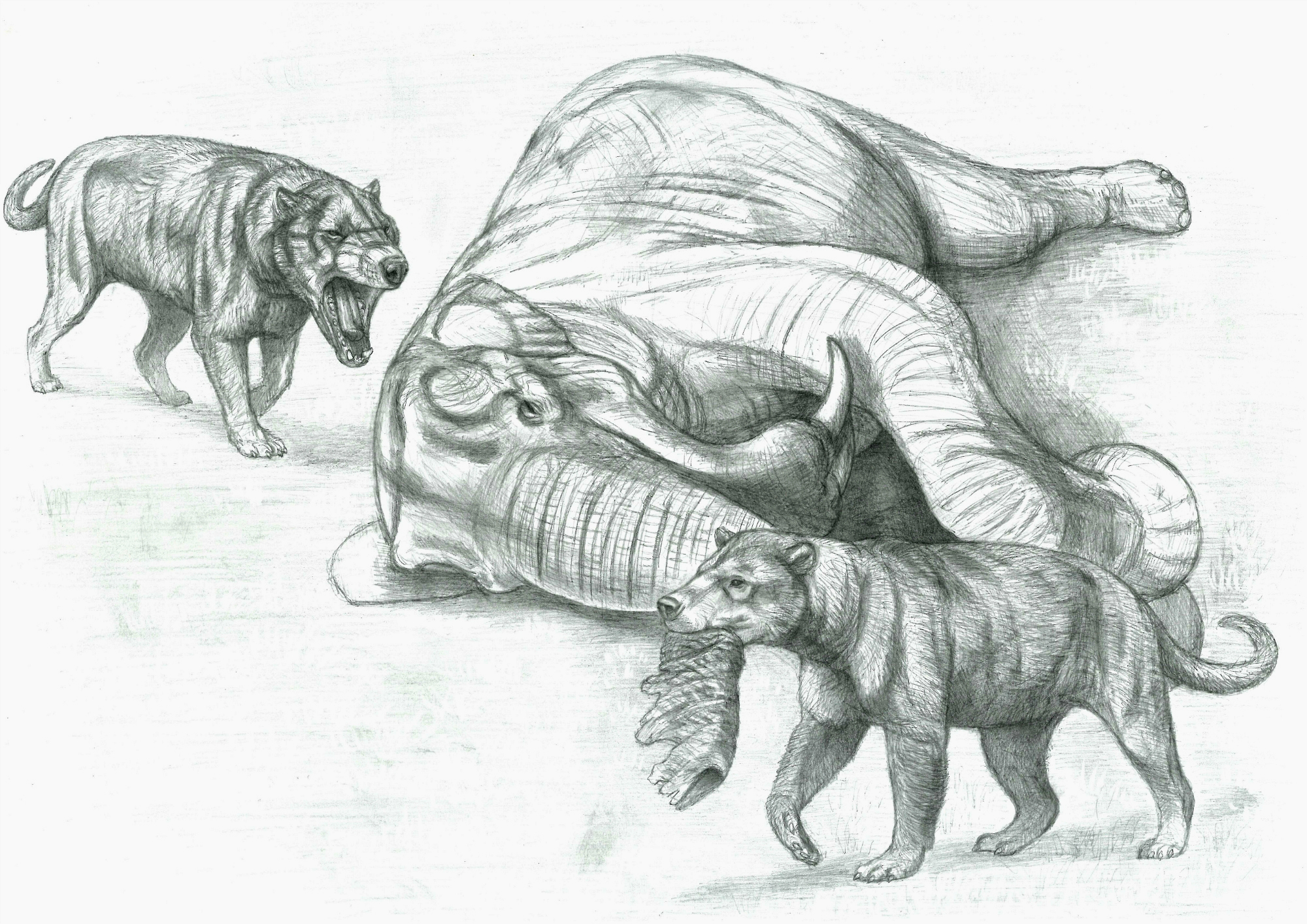ShopDreamUp AI ArtDreamUp
Deviation Actions
Description
Please note, this is only a relatively loose underdrawing for my usual mixed medium coloring.
:Idea of this image:
There were a number of large, highly formidable predators with a typical 'bone cracking and meat shearing dental combination' throughout the Miocene, a list of which includes : Agriotherium spp., Amphicyon spp., Dinocrocuta gigantea, Epicyon heydeni, Hemicyon bears and large Hyaenodontids etc... to name a few.
Among them, Amphicyon giganteus and Hyainailouros sulzeri were especially having one of the fiercest rivalries in the history of mammal carnivores: they were both some of the largest species in their respective families and were not only contemporaries in a number of Eurasian and African localities but most likely sharing very similar life styles and prey resources as well.
:Size issue:
:Idea of this image:
Amphicyon giganteus(front) and Hyainailouros sulzeri(back) from the early Miocene Eurasia, are having a brief skirmish over a carcass of an aging, 10 tons Deinotherium giganteum(died of illness or natural death, ofcourse).
There were a number of large, highly formidable predators with a typical 'bone cracking and meat shearing dental combination' throughout the Miocene, a list of which includes : Agriotherium spp., Amphicyon spp., Dinocrocuta gigantea, Epicyon heydeni, Hemicyon bears and large Hyaenodontids etc... to name a few.
Among them, Amphicyon giganteus and Hyainailouros sulzeri were especially having one of the fiercest rivalries in the history of mammal carnivores: they were both some of the largest species in their respective families and were not only contemporaries in a number of Eurasian and African localities but most likely sharing very similar life styles and prey resources as well.
:Size issue:
Hyainilouros sulzeri is said to have been very similar, almost identical to its close African relative, Megistotherium osteothlastes in shapes and size, thus having a similarly disproportionally over-sized cranial relative to the body. According to Agusti and Anton(2002), these giant creodonts had a considerably much larger head but probably almost the same or even smaller body in comparison with the contemporary Amphicyon giganteus! Authors give estimated weight of 317 kgs to the male A.giganteus in the same context, so, does it mean that Hyainailouros spp. or even perhaps Megistotherium spp. too, were in general, lighter weight than that? I leave the question to you!
:Morphological characteristics:
:Morphological characteristics:
The skeleton of Hyainailouros sulzeri from the fossil site in France shows the body proportion not unlike other hyaenodontids; very long back and tail, relatively inflexible short limbs. Like its close relative Megistotherium osteothlastes, its skull was very large relative to the postcranial which measures over 50~60 cm in length, larger than that of any modern carnivores.
The family Amphicyonidae is perhaps one of the most intriguing groups of extinct carnivores ever. They were most closely related phylogenetically to the bear family but the overall morphology was more like a 'chimera' of all major groups of Carnivora: big cat like body with long back and tail, bear like front feet and the cranial which resembles that of canids with both meat shearing and bone cracking dentitions as in hyenids. Some of them also grew to giant sizes.
The form of dentition indicates that these two Miocene giant meat eaters were occasional hunter and scavenger. We can imagine that disputes over a carcass in early Miocene between such huge bone crackers must've been rather spectacular!
The family Amphicyonidae is perhaps one of the most intriguing groups of extinct carnivores ever. They were most closely related phylogenetically to the bear family but the overall morphology was more like a 'chimera' of all major groups of Carnivora: big cat like body with long back and tail, bear like front feet and the cranial which resembles that of canids with both meat shearing and bone cracking dentitions as in hyenids. Some of them also grew to giant sizes.
The form of dentition indicates that these two Miocene giant meat eaters were occasional hunter and scavenger. We can imagine that disputes over a carcass in early Miocene between such huge bone crackers must've been rather spectacular!
~ ⓒJagroar
Image size
2000x1414px 2.25 MB
© 2014 - 2024 Jagroar
Comments53
Join the community to add your comment. Already a deviant? Log In
isnt amphyicon gigantues 750 kg max look on romus



































